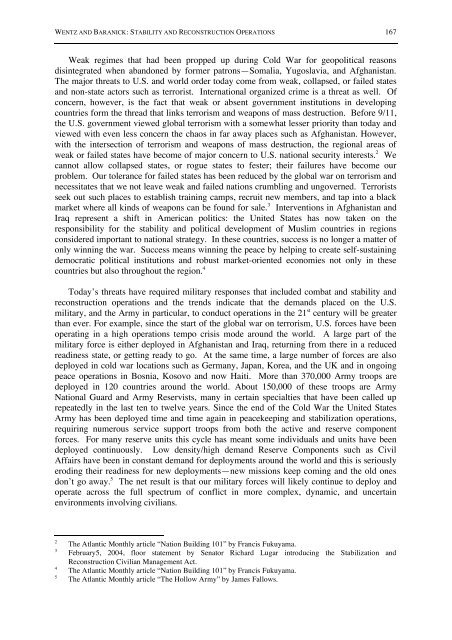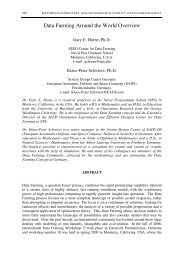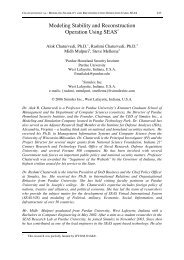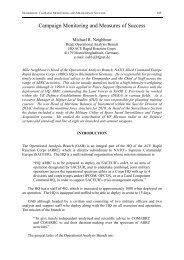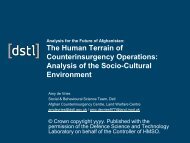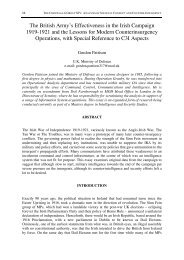Stability and Reconstruction Operations: What ... - Cornwallis Group
Stability and Reconstruction Operations: What ... - Cornwallis Group
Stability and Reconstruction Operations: What ... - Cornwallis Group
Create successful ePaper yourself
Turn your PDF publications into a flip-book with our unique Google optimized e-Paper software.
WENTZ AND BARANICK: STABILITY AND RECONSTRUCTION OPERATIONS 167<br />
Weak regimes that had been propped up during Cold War for geopolitical reasons<br />
disintegrated when ab<strong>and</strong>oned by former patrons—Somalia, Yugoslavia, <strong>and</strong> Afghanistan.<br />
The major threats to U.S. <strong>and</strong> world order today come from weak, collapsed, or failed states<br />
<strong>and</strong> non-state actors such as terrorist. International organized crime is a threat as well. Of<br />
concern, however, is the fact that weak or absent government institutions in developing<br />
countries form the thread that links terrorism <strong>and</strong> weapons of mass destruction. Before 9/11,<br />
the U.S. government viewed global terrorism with a somewhat lesser priority than today <strong>and</strong><br />
viewed with even less concern the chaos in far away places such as Afghanistan. However,<br />
with the intersection of terrorism <strong>and</strong> weapons of mass destruction, the regional areas of<br />
weak or failed states have become of major concern to U.S. national security interests. 2 We<br />
cannot allow collapsed states, or rogue states to fester; their failures have become our<br />
problem. Our tolerance for failed states has been reduced by the global war on terrorism <strong>and</strong><br />
necessitates that we not leave weak <strong>and</strong> failed nations crumbling <strong>and</strong> ungoverned. Terrorists<br />
seek out such places to establish training camps, recruit new members, <strong>and</strong> tap into a black<br />
market where all kinds of weapons can be found for sale. 3 Interventions in Afghanistan <strong>and</strong><br />
Iraq represent a shift in American politics: the United States has now taken on the<br />
responsibility for the stability <strong>and</strong> political development of Muslim countries in regions<br />
considered important to national strategy. In these countries, success is no longer a matter of<br />
only winning the war. Success means winning the peace by helping to create self-sustaining<br />
democratic political institutions <strong>and</strong> robust market-oriented economies not only in these<br />
countries but also throughout the region. 4<br />
Today’s threats have required military responses that included combat <strong>and</strong> stability <strong>and</strong><br />
reconstruction operations <strong>and</strong> the trends indicate that the dem<strong>and</strong>s placed on the U.S.<br />
military, <strong>and</strong> the Army in particular, to conduct operations in the 21 st century will be greater<br />
than ever. For example, since the start of the global war on terrorism, U.S. forces have been<br />
operating in a high operations tempo crisis mode around the world. A large part of the<br />
military force is either deployed in Afghanistan <strong>and</strong> Iraq, returning from there in a reduced<br />
readiness state, or getting ready to go. At the same time, a large number of forces are also<br />
deployed in cold war locations such as Germany, Japan, Korea, <strong>and</strong> the UK <strong>and</strong> in ongoing<br />
peace operations in Bosnia, Kosovo <strong>and</strong> now Haiti. More than 370,000 Army troops are<br />
deployed in 120 countries around the world. About 150,000 of these troops are Army<br />
National Guard <strong>and</strong> Army Reservists, many in certain specialties that have been called up<br />
repeatedly in the last ten to twelve years. Since the end of the Cold War the United States<br />
Army has been deployed time <strong>and</strong> time again in peacekeeping <strong>and</strong> stabilization operations,<br />
requiring numerous service support troops from both the active <strong>and</strong> reserve component<br />
forces. For many reserve units this cycle has meant some individuals <strong>and</strong> units have been<br />
deployed continuously. Low density/high dem<strong>and</strong> Reserve Components such as Civil<br />
Affairs have been in constant dem<strong>and</strong> for deployments around the world <strong>and</strong> this is seriously<br />
eroding their readiness for new deployments—new missions keep coming <strong>and</strong> the old ones<br />
don’t go away. 5 The net result is that our military forces will likely continue to deploy <strong>and</strong><br />
operate across the full spectrum of conflict in more complex, dynamic, <strong>and</strong> uncertain<br />
environments involving civilians.<br />
2<br />
3<br />
4<br />
5<br />
The Atlantic Monthly article “Nation Building 101” by Francis Fukuyama.<br />
February5, 2004, floor statement by Senator Richard Lugar introducing the Stabilization <strong>and</strong><br />
<strong>Reconstruction</strong> Civilian Management Act.<br />
The Atlantic Monthly article “Nation Building 101” by Francis Fukuyama.<br />
The Atlantic Monthly article “The Hollow Army” by James Fallows.


